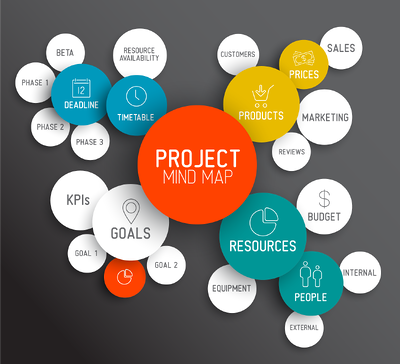 If you look at any of the most popular business process improvement methodologies, you'll find that data visualization is a common theme. Kanban, for example, is focused on visualizing workflow. Fishbone diagrams are often used to uncover cause and effect, and histograms are used by Six Sigma practitioners and others. We want to introduce you to one more tool that can play an important role in the quest for continuous improvement, mind mapping.
If you look at any of the most popular business process improvement methodologies, you'll find that data visualization is a common theme. Kanban, for example, is focused on visualizing workflow. Fishbone diagrams are often used to uncover cause and effect, and histograms are used by Six Sigma practitioners and others. We want to introduce you to one more tool that can play an important role in the quest for continuous improvement, mind mapping.
What is Mind Mapping?
Mind mapping is a technique for visualizing connections between many related ideas or pieces of information to generate new ideas. A non-linear, graphical layout is used to create a web of relationships around a central concept, idea, or problem. Although probably much older, the idea gained popularity following a 1972 book by UK researcher Tony Buzan called "Use Your Head." The technique is used in brainstorming, problem-solving, project planning, and note-taking. Mind maps take the form of a tree, starting with a core thought (the trunk) and connecting it to related ideas, big (branches) and small (twigs). Images and colored connections are used whenever possible to make the visualization more meaningful.
How Do Mind Maps Work?
The human brain does not operate in a linear fashion; instead, it employs "radiant thinking" in order to connect ideas. For example, think about when you see someone you know. You don't recall, in order, every fact you know about that person. Instead, you instantly make the thousands of associations that form the experience of being near him. Mind mapping frees the brain to leverage this radiant thinking and allows room for out-of-order, out-of-proportion thoughts to be captured and then stitched back into the tapestry of the whole idea.
Using mind maps can help you to:
Structure information: Mind maps can contain vast amounts of information. They visualize hierarchy, display relationships between multiple ideas, and make the big picture clear at a glance. Mind maps are also ideal for sharing information with others, generating new ideas, and solving complex problems.
Improve comprehension: Research shows that mind maps have proven to be effective learning aids at the primary school and university levels. Because mind maps use visualization rather than extended text blocks, people who tend to be visual learners can absorb information more quickly and retain it longer.
Enhance productivity: Because mind mapping allows you to gather and share ideas quickly while communicating effectively, they save a significant amount of time. Ideas collected during each brainstorming session are quickly turned into plans of action.
Foster creativity: The act of creating a mind map stimulates the brain in a unique way. The freedom of thought and association opens up participants to explore new ideas and possibilities. The opportunity for innovation is one of the reasons that mind maps are so popular with folks interested in continuous improvement.
How is Mind Mapping Helpful for Continuous Improvement?
Mind mapping can be uniquely helpful for individuals or teams brainstorming ideas for improvement. The visual structure makes gaps in information quickly apparent and relationships between ideas clear. The technique can be applied anytime fresh thinking is needed and works well for process development, product improvement, customer experience assessment, or any other opportunity for improvement.
How to Get Started with Mind Mapping
There are several mind mapping tools available online and several different mind mapping techniques, but you don't need mapping software or a sophisticated approach to start creating a mind map. All you need is a blank page.
To draw your map, follow the following three easy steps.
1 - Start by writing or drawing the idea you want to expand in the middle of a blank page. Your idea is going to grow outward, so the landscape orientation usually works best.
2 - Add related subtopics by connecting each to the center with a line.
3 - Repeat the process for the subtopics, adding lower-level topics as you find them, connecting each of them to the appropriate subtopic.
To enhance your maps, consider:
Use colors, drawings, and symbols as much as possible. Being as graphic as possible will encourage even more free thought.
Keep the topic labels as short as possible; a single word or picture works best. It will be tempting to flesh out the entire thought with a paragraph of text, but mind mapping is about the free association, and it works much better with high-level concepts.
Use visualization to convey meaning. You can use text size, color, and alignment to display the relationship between ideas. Perhaps thick lines mean a more robust association, whereas thin ones are more tangential. Variety helps engage your brain.
Mind Mapping Software
Once you've conquered the basics and are comfortable with your physical mind map, it might make sense to consider taking it to the next level with mind mapping software. Online tools allow you to:
- Collaborate with others in real-time, even if you are not located in the same palace.
- Attach related files such as videos, images, links, and audio files.
- Present and share your mind map and toggle between different views.
- Integrate with familiar tools like MS Office and Google Drive.
- Create and save a template library to jump quickly into a new project.
Chuck Frey of Mind Mapping Software Blog surveys to uncover the use cases and effectiveness of mind mapping in business. His research shows that more than half of respondents use mind mapping for project management, and 40% use it for strategic planning.
The most recent survey conducted in 2021 revealed that, on average, mind mapping software helps executives become 20-30% more productive. Most respondents said that it increases their creativity by 50%, a significant jump from the prior report. A whopping 72.6% of respondents said that mind mapping gives them the confidence to take on complex projects that they may have otherwise avoided.

Tony Buzan has called mind maps the “metadata of the human race.” That’s an interesting way of thinking about how powerful and ally they can be in the quest for improvement. All you need is a blank piece of paper and some pencils (preferably colored) - so why not give it a shot?


Add a Comment